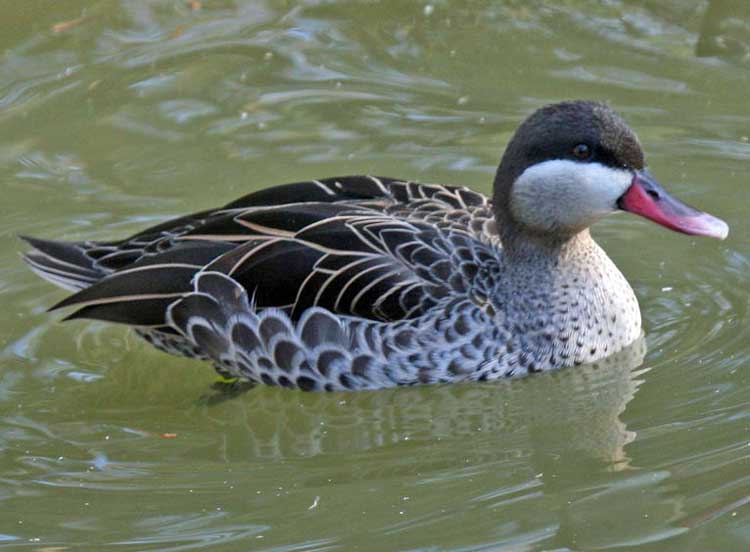
Anas erythrorhyncha (*)
Superregnum: Eukaryota
Cladus: Unikonta
Cladus: Opisthokonta
Cladus: Holozoa
Regnum: Animalia
Subregnum: Eumetazoa
Cladus: Bilateria
Cladus: Nephrozoa
Superphylum: Deuterostomia
Phylum: Chordata
Subphylum: Vertebrata
Infraphylum: Gnathostomata
Megaclassis: Osteichthyes
Cladus: Sarcopterygii
Cladus: Rhipidistia
Cladus: Tetrapodomorpha
Cladus: Eotetrapodiformes
Cladus: Elpistostegalia
Superclassis: Tetrapoda
Cladus: Reptiliomorpha
Cladus: Amniota
Classis: Reptilia
Cladus: Eureptilia
Cladus: Romeriida
Subclassis: Diapsida
Cladus: Sauria
Infraclassis: Archosauromorpha
Cladus: Crurotarsi
Divisio: Archosauria
Cladus: Avemetatarsalia
Cladus: Ornithodira
Subtaxon: Dinosauromorpha
Cladus: Dinosauriformes
Cladus: Dracohors
Cladus: Dinosauria
Ordo: Saurischia
Cladus: Eusaurischia
Subordo: Theropoda
Cladus: Neotheropoda
Cladus: Averostra
Cladus: Tetanurae
Cladus: Avetheropoda
Cladus: Coelurosauria
Cladus: Tyrannoraptora
Cladus: Maniraptoromorpha
Cladus: Maniraptoriformes
Cladus: Maniraptora
Cladus: Pennaraptora
Cladus: Paraves
Cladus: Eumaniraptora
Cladus: Avialae
Infraclassis: Aves
Cladus: Euavialae
Cladus: Avebrevicauda
Cladus: Pygostylia
Cladus: Ornithothoraces
Cladus: Ornithuromorpha
Cladus: Carinatae
Parvclassis: Neornithes
Cohors: Neognathae
Cladus: Pangalloanserae
Cladus: Galloanseres
Ordo: Anseriformes
Familia: Anatidae
Genus: Anas
Species: Anas erythrorhyncha
Name
Anas erythrorhyncha Gmelin, 1789
References
Gmelin, J.F. 1789. Caroli a Linné systema naturae per regna tria naturae, secundum classes, ordines, genera, species, cum characteribus, differentiis, synonymis, locis. Tomus I, Pars II. Editio decima tertia, aucta, reformata. - pp. 501–1032. Lipsiae. (Beer). DOI: 10.5962/bhl.title.545 Original description p.517 n.79 BHL Reference page.
Vernacular names
Afrikaans: Rooibekeend
български: Червеноклюно бърне
català: Ànec bec-roig
čeština: Ostralka rudozobá
dansk: Rødnæbbet and
Deutsch: Rotschnabelente
English: Red-billed Teal
Esperanto: Ruĝbeka anaso
español: Ánade piquirrojo
suomi: Punanokkasorsa
français: Canard à bec rouge
magyar: Piroscsőrű réce
italiano: Anatra becco rosso
日本語: アカハシオナガガモ
Nederlands: Roodbekpijlstaart
norsk: Rødnebband
русский: Красноклювая шилохвость
svenska: Rödnäbbad and
The red-billed teal or red-billed duck (Anas erythrorhyncha) is a dabbling duck which is an abundant resident breeder in southern and eastern Africa typically south of 10° S. This duck is not migratory, but will fly great distances to find suitable waters. It is highly gregarious outside the breeding season and forms large flocks.
Taxonomy
The red-billed teal was formally described in 1789 by the German naturalist Johann Friedrich Gmelin in his revised and expanded edition of Carl Linnaeus's Systema Naturae. He placed it with all the other ducks, geese and swans in the genus Anas and coined the binomial name Anas erythrorhyncha.[2] Gmelin based his description on the "Crimson-billed duck" that had been described in 1785 by the English ornithologist John Latham in his A General Synopsis of Birds. Latham specied the type locality as the Cape of Good Hope.[3][4] The genus name Anas is the Latin word for a duck. The specific epithet erythrorhyncha combines the Ancient Greek eruthros meaning "red" with rhunkhos meaning "bill".[5] The species is monotypic: no subspecies are recognised.[6]
Description
The red-billed teal is 43–48 centimetres (17–19 in) long and has a blackish cap and nape, contrasting pale face, and bright red bill. The body plumage is a dull dark brown scalloped with white. Flight reveals that the secondary flight feathers are buff with a black stripe across them. The sexes are similar, but juveniles are duller than adults.
This is a quiet species, but the displaying male has a whzzt call, whereas the female has a soft mallard-like quack.
The red-billed teal is a bird of freshwater habitats in fairly open country and is an omnivore. It feeds by dabbling for plant food, or foraging on land mainly in the evening or at night. It nests on the ground in dense vegetation near water.
This is one of the species to which the Agreement on the Conservation of African-Eurasian Migratory Waterbirds (AEWA) applies.
References
BirdLife International (2016). "Anas erythrorhyncha". IUCN Red List of Threatened Species. 2016: e.T22680290A92854310. doi:10.2305/IUCN.UK.2016-3.RLTS.T22680290A92854310.en. Retrieved 13 November 2021.
Gmelin, Johann Friedrich (1789). Systema naturae per regna tria naturae : secundum classes, ordines, genera, species, cum characteribus, differentiis, synonymis, locis (in Latin). Vol. 1, Part 2 (13th ed.). Lipsiae [Leipzig]: Georg. Emanuel. Beer. p. 517.
Latham, John (1785). A General Synopsis of Birds. Vol. 3, Part 2. London: Printed for Leigh and Sotheby. p. 507.
Mayr, Ernst; Cottrell, G. William, eds. (1979). Check-List of Birds of the World. Vol. 1 (2nd ed.). Cambridge, Massachusetts: Museum of Comparative Zoology. p. 475.
Jobling, James A. (2010). The Helm Dictionary of Scientific Bird Names. London: Christopher Helm. pp. 46, 150. ISBN 978-1-4081-2501-4.
Gill, Frank; Donsker, David; Rasmussen, Pamela, eds. (January 2022). "Screamers, ducks, geese & swans". IOC World Bird List Version 12.1. International Ornithologists' Union. Retrieved 4 July 2022.
Ian Sinclair, Phil Hockey and Warwick Tarboton, SASOL Birds of Southern Africa (Struik 2002) ISBN 1-86872-721-1
Madge and Burn, Wildfowl ISBN 0-7470-2201-1
Retrieved from "http://en.wikipedia.org/"
All text is available under the terms of the GNU Free Documentation License

